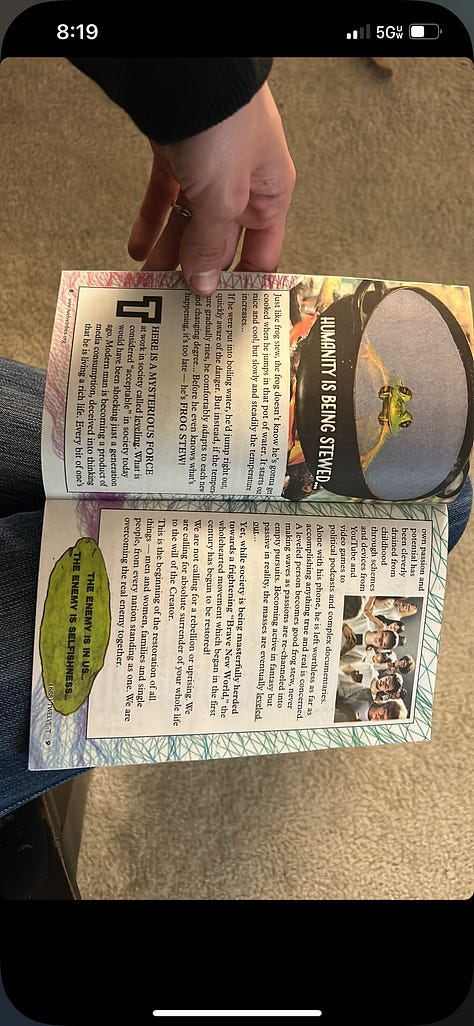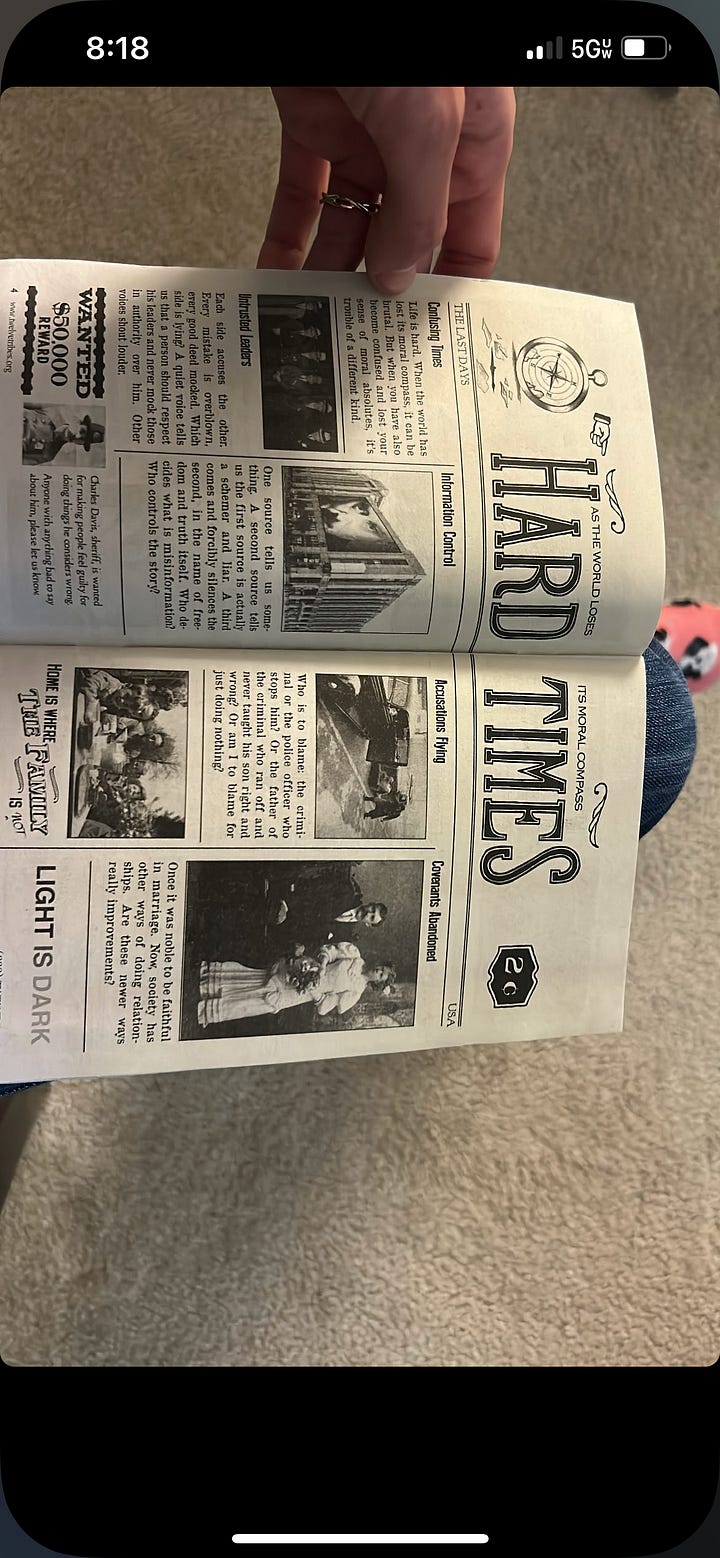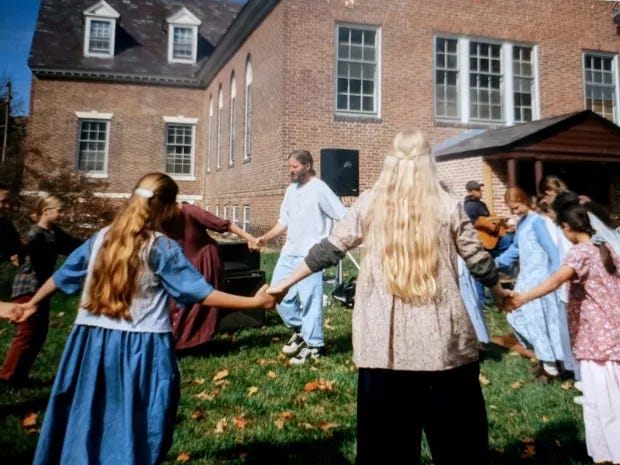My Meal at the Yellow Deli: Cult Curiosity and Unexpected Insights
So, my YouTube algorithm has outed me as someone who loves diving into the world of cults, paranormal investigations, and aliens. Honestly, it's my quirky little obsession outside of whatever outdoor adventure I'm into at the moment. Why am I drawn to such eerie topics? No clue, but I'm totally here for it.
After binge-listening to podcasts and gobbling up videos on the subject, I got this burning desire to understand the allure of cults firsthand. There's this fascinating intersection of belonging, societal psychology, and the cult phenomena that's been dissected in countless deep dives, and I just had to get a high-level overview for myself.
Cue to a few months ago, when I stumbled upon this video of a bunch of friends sneaking into the Yellow Deli. Yep, that Yellow Deli is reputed for being a cult. And let me tell you, that video wasn't just entertaining; it was downright captivating. I must've shown it to all my friends, sparking a mini-obsession around some of them.
Fast forward to my trip to San Diego, and there was no way I was missing out on visiting a Yellow Deli. The excitement was real. Beyond the cult thingy, apparently their sandwiches are great! Dragging my partner along, I was ready to unravel the mystery.
The place was straight out of a fairy tale—a quaint, yellow-painted house with a welcoming patio that felt like stepping into a happy place definitely not ran by a cult. The staff member who greeted us was so warm and friendly that any initial nerves I had about exploring a "cult" spot melted away instantly.
Inside, the Yellow Deli was the epitome of coziness, with its low ceilings, fireplace, soothing music, and an adorable little elevator. It felt like being in a little hobbit set or a fairytale cottage. And the famous sandwiches? Overhyped if you ask me. The menu was charming, the waitress was a delight, and the tea was cute AF… Also, did I mention that the Yellow Deli is open 24/7?
Kudos to their marketing overall -- it’s adorable!
But here's where it got interesting. Each menu, tea bag, you name it, had this little note: "For more info, just ask." Intriguing, right? I really wanted to “ask” but, hey, I was there for a good meal and some casual observation, nothing more.
After we'd had our fill, we bought some tea, some bread and picked up a few pamphlets on our way out. These pamphlets were the real deal, offering a deep dive into the Yellow Deli's beliefs and community ethos. And that's why I'm here writing this blog.
Honestly, on the way back I noticed some similarities with small society communities that are more common such as working for a tech company and the Yellow Deli… Both have their allure, drawing people in search of purpose. Debating on writing more about this here or later.
So, let’s unpack this!
Alright, let's dive into this pamphlet. It kicks off with the tough stuff, and honestly, a lot of what it said hit me, I get it? It touched on the loneliness epidemic, our hyper-information age, and the creeping sense of what is real and true. It painted a picture of a world where trust in leaders is thin, and moral compasses seem to be spinning in circles. Sounds familiar and or you’ve heard someone talking about it outside a cult.
The pamphlet then wades into the murky waters of ethical dilemmas and the concept of abandonment, wrapping it all up in the idea of a 'spiritual covenant'. Now, again, this isn't exclusive to cult territory—these themes pop up in various spiritual movements and new-age ideologies. It's like we're all in this cosmic soup, trying to figure out the ingredients.
As it progresses, the narrative starts to feel a bit like a broken record, echoing common religious themes—what's right, what's wrong, based on the bible and the whole existential mumbo jumbo. It's not necessarily off-putting, but it's definitely a case of "Huh, so you’re telling me we should believe in THIS thing and only THIS because YOU know what’s the right thing to believe?."
Then things escalate. We're hit with this analogy about frogs being boiled alive, oblivious to the changing waters around them. It's a stark picture of our desensitization to the world's shifts faster and faster and we need a wake-up call for humanity.
A bit of backstory (going in depth in a sec, just bare with me): the cult sprung up in the '70s, riding the wave of the hippie movement. The pamphlet romanticizes this era of community, peace, and a collective side-eye at the establishment. It's all about getting back to the grassroots, fostering tight-knit communities, and essentially, living the dream of a harmonious coexistence.
Now, here's the classic cult playbook move: playing on fear. The pamphlet takes a deep dive into the pool of collective anxieties, setting up the stage for their grand solution—enter, the Messiah. It's a familiar tune: the world is a mess, but hey, we've got the ultimate fix.
And then, we're ushered into the realm of love and unity. Of course, no cult's going to lead with their controversies or the less savory aspects of communal living. Instead, it's all about belonging, finding a purpose, and walking the path of enlightenment together.
The pamphlet throws some staggering stats at us—trillions of texts, billions of Google searches, and an avalanche of digital content. It's a vivid illustration of our shift towards tech dependency, nudging us to reconsider the value of human connection.
In its closing arguments, the pamphlet circles back to moral dilemmas, tugging at the strings of contemporary concerns—environmental ethics, justice, and the battle between integrity and corruption. It's crafted to resonate with almost everyone, to make you pause and ponder if maybe, just maybe, they're onto something.
So, there you have it. A tour through a pamphlet that Dillon had to hear first hand on a long drive back from San Diego to Orange County, so much about purpose, connection, and the direction of our collective journey. It's food for thought, served up with a side of existential inquiry. And whether or not we buy into their answers, the questions they raise are undeniably relevant.








Is the Yellow Deli a Cult then?
Did I mention the Twelve Tribes is the group behind those cozy deli vibes?
Now, before we wade into the murky waters of controversy, let me set the stage a bit. The Twelve Tribes, known for their quaint Yellow Delis and communal living, paint a picture of simplicity and shared values that I wrote above. But as I peeled back the layers, I stumbled upon a few sketchy and sus things.
I'll weave the story and sprinkle in some links for a deeper dive—controversies, TikToks from those raised within the Twelve Tribes, and bits of their history—to stir up some critical thinking. For those curious souls eager to explore, check out the links. Immerse yourself in the narratives and uncover the multifaceted story of the Twelve Tribes. Whether you're here to sip some tea while you get some knowledge or just because I sent you a link, remember:
“life's richness, much like a well-stacked deli sandwich, lies in its layers and complexity, offering varied flavors to satisfy different palates.”
Why the 70s
The 1970s was a fertile ground for the formation of new religious movements and groups that many would label as cults. While it's challenging to pinpoint an exact number of cults formed during this era due to the varying definitions and recognitions of what constitutes a cult, it's clear that this period saw a significant surge in such movements.
Several factors contributed to this phenomenon:
Cultural and Societal Shifts: The 1970s were a time of significant social upheaval and transformation. The counterculture movements of the 1960s had set the stage, challenging traditional values and norms regarding politics, religion, sexuality, and personal freedom. As these ideas continued to evolve into the next decade, there was a widespread questioning of authority and a search for alternative lifestyles and spiritual paths.
Disillusionment with Established Institutions: The Vietnam War, political scandals like Watergate, and economic uncertainties led to a widespread disillusionment with government and established institutions, including traditional religious organizations. Many people, especially the younger generation, were seeking new sources of meaning and community outside the mainstream.
The New Age Movement: The 1970s saw the rise of the New Age movement, which embraced a wide range of spiritual and mystical traditions, from Eastern philosophies to indigenous spirituality and modern esoteric practices. This movement's eclectic and inclusive nature attracted many who were looking for more personal, experiential forms of spirituality.
The Quest for Personal Transformation: There was a growing emphasis on self-exploration, personal growth, and transformative experiences during this time. Many cults and new religious movements promised profound personal enlightenment, communal living, and a break from conventional life paths, which resonated with individuals seeking radical change.
Media and Communication: The role of media and emerging communication technologies cannot be overlooked. Influential books, charismatic leaders gaining media attention, and the use of newsletters and early forms of networking helped these movements spread their messages and attract followers from across the United States and beyond.
Psychological and Sociological Factors: Psychologists and sociologists of the time began to study the appeal of cults, pointing to a mix of existential anxiety, the need for belonging, and the appeal of having a clear, definitive purpose as powerful draws for many individuals.
Drugs: In the 70s, psychedelics like LSD and mushrooms became gateways to deeper spiritual exploration, resonating with the era's shift towards alternative spiritual paths.
The Cult Wave
I've always been fascinated by California's flair for being a cult cradle, and living here has only deepened my intrigue for that. It's almost a badge of honor – so many of the most notorious cults hail from here! California, with its history of embracing the unconventional, and openness to fresh perspectives, has provided the perfect backdrop for these groups to flourish. The state's influence and diverse population make it a prime spot for the emergence of cults and new religious movements. Definitely future blog post!
Food for Thought: California is very influential creating multiple cults, but let's not forget how many tech companies have been established in Silicon Valley, how much new technology has been developed there and how many movies are also produced in Los Angeles … Connections?
Cults from the 70’s
The Peoples Temple: Led by Jim Jones, this group is infamously known for the Jonestown Massacre in 1978, where over 900 members died in a mass suicide/murder in their Guyana commune. Initially founded in the 1950s, the Peoples Temple gained significant traction in the 1970s, attracting followers with its message of social equality and communal living.
The Children of God (now known as The Family International): Founded by David Berg in the late 1960s, this group became particularly controversial due to its unconventional sexual practices, including the use of sex for recruitment, and its apocalyptic teachings.
The Unification Church: Also known as the Moonies, after their leader Sun Myung Moon, this group was famous for its mass wedding ceremonies and aggressive fundraising practices.
Heaven's Gate: Although the infamous mass suicide associated with Heaven's Gate occurred in 1997, the group was actually founded in the early 1970s by Marshall Applewhite and Bonnie Nettles. They believed that they could ascend to a higher spiritual level and eventually leave Earth in a spaceship.
The Symbionese Liberation Army (SLA): While not a religious cult in the traditional sense, the SLA was a radical left-wing group known for its bank robberies, murders, and the kidnapping of heiress Patty Hearst in 1974. The group had cult-like characteristics, including a charismatic leader and a strong ideological commitment that demanded total loyalty from its members.
Rajneesh Movement: Founded by Bhagwan Shree Rajneesh (later known as Osho) in the late 1960s in India, the movement gained international attention in the 1970s and 1980s. The group is known for its controversial practices and beliefs, as well as the bioterror attack in Oregon in 1984 when they attempted to influence local elections by incapacitating voters.
Scientology: Though founded in the 1950s by L. Ron Hubbard, Scientology saw significant growth and came into the public eye in the 1970s. Known for its secretive practices, celebrity followers, and controversial legal battles, Scientology remains a highly debated organization.
Twelve Tribes
It all started with a group of spiritual seekers in Chattanooga, Tennessee. Led by Gene Spriggs, they shared a vision to live out the New Testament teachings authentically, aiming for a community-centric lifestyle reminiscent of the early Christian church. Hippies meet (Yahshua aka Jesus in Hebrew).
Part of their journey began with the opening of the Yellow Deli in 1973, a venture that extended beyond mere dining to embody their collective ethos. This model wasn't confined to Tennessee; it went global, from the US to Japan and Argentina, showcasing their commitment to communal living and shared beliefs.
Their Controversies and Cultish Activities:
First off, their approach to discipline and schooling has raised more than a few eyebrows. The talk around the internet is that their practices lean towards the, let's say, unconventional side, sparking debates on children's rights and education.
Then there's the whole labor situation. Apparently nobody makes money at the Yellow Deli. Technically everyone there works for free. They even mention that on their website“This is not your normal 9/5 job”
And let's not forget about the allegations we can find with a quick TikTok search. Some former members describe the challenge of leaving the community had a hefty emotional toll. Tik Tok here.
My Thoughts:
Wrapping up this post (because, let's be real, I could go on forever), I want to circle back to the heart of why I've been sharing this journey with you. This isn't about casting the Twelve Tribes members as hippie dippies or villains, or even about me uncovering some grand mystery. It's about peeling back the layers of human connection and understanding the magnetic pull of belonging that these movements exert.
The thing is, it absolutely baffles me how someone can go from living their 'normal' life to suddenly diving headfirst into beliefs that seem so far from usual. But here's the thing – the themes these groups dance around, like community, love, and purpose, are universal and we all want that in one way or another.
Yet, it's crucial to recognize that the controversies surrounding the Twelve Tribes are far from benign; in fact, they're deeply disturbing. From their approach to discipline to their communal lifestyle, these issues raise serious questions. It's not about painting everyone with the same brush, but it's important to ask: if some members truly stand by these practices, what led them down such a drastically different path? What makes them believe these contentious practices are acceptable?
And this isn't just a cult thing. It's a human thing. We see echoes of this in our workplaces, our favorite brands, and the missions we rally behind. It's all about that sense of belonging (right or wrong), driven by charismatic leaders who know just how to strike the right chord.
So, I'm not closing the book on the Twelve Tribes or the Yellow Deli. In fact, I want to swing by again, and talk more. If anyone's up for a little adventure into their world or try some average sandwiches and question their ideologies, let me know. And no, this isn't me looking to jump into the cult life; it's pure, unadulterated curiosity about the human psyche.
And if there's another group out there open to a friendly chat over a cup of tea about life on the inside, I'm all ears. After all, isn't life just one big exploration of the stories and beliefs that bind us together? Let's keep the dialogue open and the curiosity flowing.







